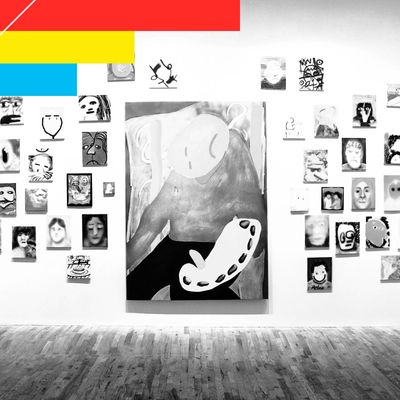
I know. We’ve all had it up to here with top-tens and end-of-year listicles. Even writing them is like running at 100 mph in first gear. Corrosive. Maybe it’s too late to add another to the pile. But four shows have been gnawing at me since I left them off my earlier list. Here they are, reviewed or recalled in three sentences. Two I left off my first list because I was skittish about writing them; two because I forgot about them. And one mad non-art/art performance that encapsulated a change in time.
Jordan Wolfson, David Zwirner Gallery
Fetishistic, Bronzino levels of weird realism and a fear of going against the group mind and being branded “sexist” (again) for feeling turned on by Jordan Wolfson’s creepy/beguiling, pole-dancing, animatronic Female Figure transformed my inner critic into a staring mongoose unable to share his reactions. Female Figure is sure to seem out of date and cheesy as soon as the next technological iteration comes along; this figure looks at us in a mirror, her eyes following us wherever we walk, gyrating, music blaring, intermittently uttering inanities or profundities, like, “My mother is dead, my father is dead, I’m gay, I would like to be a poet, this is my house” — Wolfson somehow crept in and turned the inside of my head into his house. Being sexist, sleazy, and brash and having more money than God to realize one’s artistic dream isn’t anything special, but the animalistic drive and quasi-pornographic and surveillance aspects of all this made me feel desirous, oppressed, confused, and reduced to acknowledging that this artist had zapped me.
Sam Moyer, Rachel Uffner Gallery
In May, walloped with a perfect lesson in giving in to art that we don’t think we like but then getting blown away, I instantly realized that Sam Moyer’s breathtaking, gallery-filling floor installation proved that I was wrong in thinking that this artist’s tie-dyed and bleached-allover abstractions were just more atavistic Zombie Formalism. Instead, I beheld something more powerful than a Richard Serra — a massive slab of white-veined marble on the floor beneath an enormous painting suspended from the ceiling — like a flat, artificial cloud over something enormously heavy. A crack of synesthetic thunder sounded inside me as I felt the cold, hard marble through my shoes, grasped the lightness of the canvas by comparison, and came to terms with an artist bypassing Serra’s fearsome weight and brawny power; finding essences between painting and sculpture, perception and experience, I crossed a delicate line between something I’d never seen before and something I already feared I’d never see again.
Austin Lee, Postmasters Gallery
Had Laura Hoptman’s “Forever Now” show at MoMA simply been titled “Seventeen Painters,” to the museum’s PR department’s horror, I’m sure, the show might have been better received in the art world than it has been, seen as a simple, subjective, even arbitrary snapshot of the medium from one curator’s point of view — not to say it isn’t gutsy that Hoptman takes a stand at a museum generally averse to contemporary painting from any place other than Germany. Personally, had Austin Lee been in the 17-person show (as well as Sam Moyer, above, and a number of others I’ve mentioned elsewhere), I think that Hoptman’s show would have had more elements that felt outright by-the-seat-of-its-pants, less knowing, more keyed-up in terms of color, open to wild-style, maybe ugly, passages. That sums up Lee’s brilliant debut, anyway, and what I hope we see a little more of from curators in general — a willingness to let a little more in and appreciate technical achievements that look like failures but that are totally successful in their own right.
Ernest Cole, Grey Art Gallery
Waves of pain, rage, sorrow, and pity gripped me at the sight of Ernest Cole’s stark black-and-white photographs of the hell on Earth that was apartheid South Africa in the 1950s and 1960s. Pictures of black miners, household help coming from and going to jobs in white homes, children being children in the wreckage of this askew society, segregated crowds, protesters, police, and great historical events happening in everyday life give us the work of a photographer who, more than anyone else, captured this nightmare as surely as Goya depicted Napoleonic soldiers going about their mad business. It’s silly to use one kind of work to shake a stick at another — and I love beautiful contemporary pictures of carefree youth and riveting pictures of the life of global commerce — yet this show made me long to see more artists like Cole (photographers like Zoe Strauss and LaToya Ruby Frazier who today give us images of worlds gone wrong) getting close to situations that need to be gotten close to and pictured in ways that with no text whatsoever bring tears to one’s eyes without a hint of spectacle.
Bonus: Luis Suarez at the World Cup
When I saw Uruguayan soccer star Luis Suarez bite an Italian opponent and then, when called out on it, immediately point to his own jaw as if he’d been the one fouled, it seemed a perfect metaphor for the change from one time to another. In 2006, Zinedine Zidane was famously sent off the pitch for head-butting his Italian opponent; Zidane’s was a pathos-filled reaction to simmering racism, an action that had something of forlorn tragedy about it, a person of the third world confronting someone from the first. Eight years later, by comparison, Suarez’s mad act seemed more about the raging self-interest, ferocious excess, and mindless appetite that marks our moment in the global sun.




